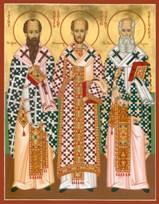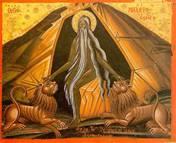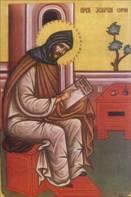Church Established: Cappadocian Fathers, Macarius, and Ephraim
UNIT 6: THE CHURCH ESTABLISHED
Objective: Students should be able to identify several of the early church Fathers and understand their teachings, to discuss the development of monasticism and the monastic way of life, to identify and discuss the importance of such great monastics as St. Anthony the Great, St. Gregory Palamas, St. John Climacus, and St. Mary of Egypt, and to recite the Jesus Prayer.
WEEK 1: THE CAPPADOCIAN FATHERS, MACARIUS, AND EPHRAIM
 The St. Basil the Great, St. Gregory Nazianzus (the Theologian), and St. Gregory of Nyssa are often grouped together of the Cappadocian Fathers (because of their cities); St. Basil, St. Gregory Nazianzus, and St. John Chrysostom are also known as the Three Hierarchs. Each has his own feast day, but the three have a day together as well. Try again copying the page, cutting apart the biographies, and giving each student 5 minutes to prepare a presentation on one of these great saints:
The St. Basil the Great, St. Gregory Nazianzus (the Theologian), and St. Gregory of Nyssa are often grouped together of the Cappadocian Fathers (because of their cities); St. Basil, St. Gregory Nazianzus, and St. John Chrysostom are also known as the Three Hierarchs. Each has his own feast day, but the three have a day together as well. Try again copying the page, cutting apart the biographies, and giving each student 5 minutes to prepare a presentation on one of these great saints:
St. Basil the Great:
Basil was born in the city of Caesarea some 300 years after the time of Christ. He was raised by his grandmother, Macrina, who told him and his brothers and sisters about how his grandfather had been killed by lions because of his faith in Jesus. Basil wondered about this. Why would someone waste his life for just a belief?
When Basil grew up, he went to study in the great university at Athens. There he began to think that he was very wise and argued with the other students about all sorts of things, forgetting about Jesus. Then, one day, a messenger ran up. He told Basil that his brother Naucratius had died all of a sudden. Basil could hardly believe the news. He went right away to Caesarea. Here he realized that Naucratius, while not as smart as Basil, had shown love and joy in his whole life because of Jesus. Basil prayed and told God he was sorry he had forgotten the teachings of his grandmother about Jesus. Now, Basil was ready to serve the Lord, but how and where would he go?
Basil first went to the desert. There he learned about men who served the Lord alone in the wilderness. Basil decided to begin a monastery – a place where men called monks could live a life of prayer and holiness together. They wore simple clothes and raised their own food. Every day they would pray, but they would also serve the poor and needy. Basil started hospitals and homes for old people and orphanages for children with his monks. The rule of St. Basil about how to run a monastery is still followed all over the world today.
Then, Basil went home to Caesarea. There he was ordained a priest. One day during liturgy the earth began to shake. It was an earthquake! (Try some sound effects and shaking here.) The whole church fell down around Basil, but he was protected by the Lord. The whole city had fallen down and was on fire. Basil gathered the Christians and took care of people who were hurt and brought food for the hungry. Because of his loving service, Basil became bishop of Caesarea. Once, when people had no money or food, Basil asked the rich people for some money and had bakers make loaves of bread with the money inside! He gave it to the poor people. Many people remember this by making a special bread called “Vasilopita”, or Basil’s bread.
Meanwhile, in other cities, many people began to leave the true teachings of the church and believe the false teachings of Arius. Even the new emperor believed the teachings of Arius. Basil was arrested by the soldiers and taken before the emperor. Would he, like his grandfather, have to die for his beliefs? He stood, an old man, before the emperor and proposed to test whose belief was right. The church doors were closed and everyone moved away. Whoever’s prayers God answered would be allowed to worship. First, the Arians would pray and see if the church doors would open; they prayed and nothing happened. Then, Basil prayed and the doors opened all by themselves! Basil and the true Christians were safe from the emperor. God’s power was proof.
In the last years of his life, Basil wrote many books, taught in the monastery, and cared for the poor. He wrote down the Divine Liturgy known to this day as the Liturgy of St. Basil and celebrated on many feast days of the year. Whose liturgy is celebrated most of the time? On which 10 Sundays do we celebrate the Liturgy of St. Basil? Theophany, the day before Christmas, St. Basil’s day (Jan. 1), the five Sundays of Great Lent, and Holy Thursday and Saturday.
St. Gregory Nazianzus:
Gregory was born in the small town of Nazianzus in Asia Minor. His mother taught him about Jesus. But Gregory wondered, why did he never see Jesus? Was Jesus real?
Gregory was a very good student. He first studied in the little school in Nazianzus. Then he went to Alexandria, and finally, when Gregory was 16 years old, he decided to go to Athens. His parents were very sad; he would be so far away. Gregory boarded the ship and set sail. But, soon a storm came. It was so fierce that the captain lost control of the ship. For days they were lost in the darkness and rain. They had no food or water. Gregory prayed and prayed. Finally the storm ended and another ship came, giving them food and supplies. They were saved! Gregory knew that his prayers had been answered and he knew that Jesus was really God.
In Athens, Gregory met his old friend Basil from the school in Alexandria. They were both studying in Athens. Soon the two friends were living together and spent 10 years studying in Athens. Finally, Gregory got a letter from home. His father, now the Bishop of Nazianzus, was old and needed help with his work. Gregory left Athens and his friend Basil and went home. His family were so happy to see him! Gregory helped his father to manage their farm and home, but he became ill. He left Nazianzus to join Basil at a monastery in the mountains and there got well again.
But, all was not well at home. Gregory traveled to Nazianzus for a visit. As he approached his house, he saw a crowd of unbelievers with clubs and logs! They were going to batter down the door and kill his family! Gregory was a small, shy, bald man, but he ran right in front of the crowd and stopped them at the door. He spoke to them for an hour, telling them about Jesus and God, until the whole mob became Christian! After this, the people of Nazianzus loved Gregory and his family. They asked for Gregory to be their priest. Gregory fled back to Basil and the monastery, but Basil sent him back; God had called Gregory to be priest and he must obey.
Several years later, when Basil was Bishop of Caesarea, he ordained Gregory Bishop of Sasima. Gregory was angry; he did not want to go to Sasima. He refused to obey. The next year was a terrible one – first his beloved brother Caesarius died, then his sister, his father and mother, all the animals of the land and even the crops with a hailstorm – even his good friend Basil died. All his family and friends were gone; Gregory cried and cried. He went out alone to the mountains, lost in his loneliness. But, Gregory came back from the mountains a new man, strong in the Lord. He was now not afraid to teach the people. He wrote books and letters about the Lord. Many of his writings we have to this day. Because of his wise writings, Gregory of Nazianzus is also known as Gregory the Theologian.
After Basil’s death, the burden of defending the Church against Arianism fell to Gregory. He fought for 10 years. Finally the Emperor Valens, an Arian, died in a battle with the Visigoths, barbarians threatening the Western Empire, and Theodosios the Great, an Orthodox Spaniard, ascended the throne. When Gregory was asked by Orthodox believers to come to Constantinople, he could find not a single church that remained faithful to the creed. He settled in the suburb of Nicea and there began to hold services in a small chapel. From there he preached brilliant defenses of Orthodox theology. When the Second Ecumenical Council met in 381, called by the Emperor Theodosios, Gregory defended Orthodoxy and the doctrine of the Holy Trinity triumphed. Gregory was offered the post of Patriarch of Constantinople, but retired to Nazianzus and died there peacefully, his work accomplished, in 389 AD.
St. Gregory of Nyssa:
St. Gregory was born about 300 years after the birth of Christ. He came from a strong Christian family; his brothers, St. Basil the Great and St. Peter of Sebastea, and his sister, St. Macrina, are all remembered today for their holiness. Their parents, Sts. Basil and Emmelia, died when Gregory was very young. Gregory was brought up by his older brother Basil and his sister Macrina. He was taught in the best schools of the day and was especially good at public speaking. But, he was a shy boy, living in the shadow of his famous brother.
Soon after he finished school, Gregory married a Christian girl named Theosebeia and became a teacher. But, it was not long before he left teaching and became a priest. After several years of faithful work, his brother Basil chose Gregory to become bishop of Nyssa. Nyssa was a small diocese, modest but politically important. Its new bishop had a very difficult job. Many of the people of Nyssa believed the false teachings of Arius and constantly argued with their new bishop. Finally, they told the governor that Gregory had stolen some money, and Bishop Gregory was arrested by the soldiers during the reign of Emperor Valens. He escaped and had to spend many years in hiding until the emperor made him bishop again.
Soon afterward, his brother Basil died. Now Gregory became one of the leading men of the church, standing firm for the true teachings of Jesus against many false teachers. Gregory traveled all over the empire to bring order and discipline into confused churches. He was a leader at the general councils of Antioch and of Constantinople. It is thought that he helped write the second part of the creed adopted at these councils. During his life and after his death, Gregory was recognized as one of the greatest Christian teachers. He wrote several books and letters that we still can read today. Finally, after a long and full life, Gregory, Bishop of Nyssa, joined his brothers and sister with the Lord in the year 395 AD.
St. Macarius the Great:
 Macarius was born in Egypt. His father was a priest. He married as his parents wanted, but his wife died very young and Macarius went into the desert near the village of Scetis, where he spent 60 years seeking the Kingdom of Heaven. He prayed and fasted so often that he was very thin. His whole attitude toward the Christian life was one of living it inwardly, without complaint. Even when falsely accused by a village girl of her pregnancy, he quietly cared for her until she told the truth. Macarius so fully succeeded in clearing his mind and heart from evil thoughts and desires, that God began to work miraculously through this great saint. He even raised the dead from the graves.
Macarius was born in Egypt. His father was a priest. He married as his parents wanted, but his wife died very young and Macarius went into the desert near the village of Scetis, where he spent 60 years seeking the Kingdom of Heaven. He prayed and fasted so often that he was very thin. His whole attitude toward the Christian life was one of living it inwardly, without complaint. Even when falsely accused by a village girl of her pregnancy, he quietly cared for her until she told the truth. Macarius so fully succeeded in clearing his mind and heart from evil thoughts and desires, that God began to work miraculously through this great saint. He even raised the dead from the graves.
Much of what we know of the life of St. Macarius comes from stories told about him by others. Even in the desert, occasionally a visitor would come by camel to collect salt from the lakes nearby. They would take and sell the baskets woven by the various monks and hermits. And Macarius, himself, did not stay put. He had to travel 40 miles across the desert each week to reach the nearest Church for liturgy. He also visited St. Anthony the Great and wove rope with him, talking of various things.
Macarius became known for his loving and concern. Once, when a fellow monk was ill and asked for sherbet to cool his burning tongue, Macarius secretly crossed the desert to fulfill his desire. Another time he showed such love and concern for a pagan he met on the street, that the man became a Christian. And, despite his greatest wishes to remain secluded with his Lord, Macarius saw the need for Liturgy and allowed the bishop to ordain him so his brother monks and hermits would not have a 40-mile trip each week.
Arianism also touched the life of Macarius. When Athanasius died, an Arian bishop was installed in Alexandria by the Emperor Valens. Macarius opposed this appointment and was exiled to a small pagan island in the Nile Delta. While there, the pagan priest’s daughter began to have terrible fits; she was possessed by a demon. When Macarius prayed, she was healed. The people tore down the pagan shrine and built a church! The government was quick to send Macarius back to his desert.
 Macarius lived for 90 years. One of his disciples was Paphnutius, another saint. Before Macarius’s death, St. Anthony and St. Pachomius appeared to him and told him he would die in 9 days. Just before he died, Macarius saw a vision of cherubim and the heavenly Kingdom. He died in the year 390 AD.
Macarius lived for 90 years. One of his disciples was Paphnutius, another saint. Before Macarius’s death, St. Anthony and St. Pachomius appeared to him and told him he would die in 9 days. Just before he died, Macarius saw a vision of cherubim and the heavenly Kingdom. He died in the year 390 AD.
St. Ephraim the Syrian:
Ephraim was born in Syria in 306 AD of poor parents during the reign of Constantine the Great. He spent his early years in somewhat wild behavior, but suddenly met Jesus in a time of spiritual crisis. His whole life was changed in that instant. He first became a hermit and then went to a monastery, where he was a disciple of St. James of Nisibis. In time, he became headmaster of the school of Nisibis.
The city of Nisibis was besieged by Sapor II of Persia over and over. He finally conquered Nisibis in 363 AD. Ephraim, along with most of the Christians, fled to Roman territory. Ephraim lived outside the city of Edessa in a small hut as a hermit. But Ephraim loved work – he wrote constantly, studied the Bible, prayed, and taught the monks and the people of Edessa. A multitude of his books and prayers have come down to us today. His most famous prayer is the one we say during Great Lent: “O Lord and Master of my life…”
Ephraim the Syrian was a contemporary of St. Basil. The two great men met in Caesarea. Ephraim spoke only Syrian and had come with 2 monks as interpreters. St. Basil was told by the Lord to have the Syrians brought to him. After the liturgy, the two saints talked long and hard. Ephraim told Basil that he needed to speak Greek if he were to spread God’s word to more people. He asked Basil to pray for this gift. Both saints prayed together for hours and, in the end, Ephraim spoke perfect Greek and Basil spoke Syrian!
The people of Edessa came to love their monk and tried by force to make him bishop. He ran through the streets of the city, pretending to be crazy, with his clothes falling off. Thinking he was mad, the people left him in peace. St. Ephraim died in old age in the year 373 AD.
Discussion:
With the class, compare and contrast these great Church Fathers. Each had a monastic background. Each had a great deal to do with the struggle against Arianism, which did not end with the victory of Athanasius at the Council of Nicea.
Quiz Questions:
- Name the Cappadocian Fathers. List 2 facts about each of their lives.
- Name the Three Hierarchs.
- Name the author of the Lenten prayer, “O Lord and Master of my life…” and tell 2 facts about his life.
- Name the Egyptian monk of Scetis and tell 2 facts about his life.